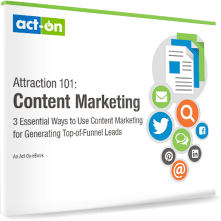Last week we published a blog post, “Why Blogging Is More Important Than Ever” that’s a reminder about  all the ways that blogging can bring you traffic and credibility, and a collection of smart tactics to take your blog posts to the next level.
all the ways that blogging can bring you traffic and credibility, and a collection of smart tactics to take your blog posts to the next level.
To look at the bigger picture: there are a lot of marketers who are ready to start blogging, but need just a little help on the technology side. Creating and maintaining a blog is no longer rocket science; you don’t need to be a skilled coder to build a functioning website, whether that site hosts just your blog or other pages as well.
This post is designed to help you get started on one of the most (deservedly) popular blogging platforms, WordPress.
Assess Your Skill Level
When you first look into building your blog, you might encounter some unfamiliar words and phrases. Acronyms like “PHP” and “FTP” and phrases like “content management system” can sound like another language if you’re not well-versed in building and managing websites. Don’t let that stop you from building and launching a blog through WordPress.com. WordPress.com offers users an easy way to set up and manage blogs without having to worry about the technical parts of web management, such as setting up a hosting account. More tech-savvy users might want to pursue WordPress.org because of the greater freedom it offers.
Here’s your first decision: figure out whether wordpress.com or wordpress.org is right for you.
wordpress.com vs. wordpress.org
Here’s how and why these two systems (with similar names) are different:
- .com is a commercial website with limits.
- .org is open source software that provides a framework for building blogs and websites. It can be used as a content management system, which is an interface that allows users to create, edit, organize, and publish their web content.
| wordpress.com | wordpress.org |
| Nothing to download or install | Must download and install the software |
| Hosting is provided | Need to purchase your own hosting |
| Less control of content, themes, plug-ins | Virtually no limits on what you can do with your themes, content, and plug-ins |
| Free for the basic package; must pay for more storage space and fewer restrictions | Free to download; must pay for premium themes, plug-ins, and for hosting |
For bloggers with limited technical experience or no time to spend on that aspect of managing a website, wordpress.com is the way to go. The rest of this post will focus on walking you through how to do that so that you gain the confidence you need to get started.
Register Your wordpress.com Account
 The first step to becoming a WordPress blogger is to register your account. You’ll need to enter your email address to verify your account. Then choose a username and password.
The first step to becoming a WordPress blogger is to register your account. You’ll need to enter your email address to verify your account. Then choose a username and password.
Pick the Plan That Fits Your Needs
WordPress.com offers three website packages: Basic, Premium, and Business. The plan that’s best for you depends on the levels of customization and support you need and the amount of storage space you plan to use for photos and videos.
Basic Plan
- Free to create your website.
- Your URL will be “yourblogname.wordpress.com” unless you opt to register your own domain name. I recommend that you do spend the extra $18/year to make your blog “yourblogname.com” (or .net, .org, or any one of the other top-level domains available for WordPress.com users). Using a custom domain gives your blog a more professional image and makes it easier for visitors to remember.
- 3 GB of photo storage available. No video storage.
- Access to the WordPress.com forums. This community can provide you with answers to most questions you will have about using WordPress.
- More than 120 free themes available for you to choose from. Your website’s theme is its overall look and feel and includes elements such as layout and color scheme. In addition to these free themes, you have the option to purchase premium themes.
- Basic customization options. With this package, you can add widgets to your pages, upload unique background and header images, and add custom content to your blog. Widgets are in-page applications that allow your blog’s visitors to interact with it beyond simply reading it. For example, you might want to embed a YouTube video in a blog post and allow readers to view the video without leaving the page. You can do this through a video widget.
Premium Plan
- $99 per year.
- With this plan, you choose a custom domain name for your blog.
- 13 GB of storage for photos and videos.
- Direct email support from WordPress’ team of IT staff.
- Greater customization options than the Basic package offers. With the Premium Plan, you can alter your website’s CSS to create a custom look.
Business Plan
- $299 per year.
- Your custom domain name.
- Unlimited storage for photos and videos.
- Direct email and live chat support from WordPress’ support staff.
- Your choice of 120 free themes and more than fifty premium themes.
- The ability to modify your blog’s CSS to create a unique look and feel.
Create Your Public Profile
When you blog on WordPress, you’re not alone. You’re part of a whole blogging community. Build your identity (and awareness of your company) in this community by setting up your public profile. You can ![]() access your public profile through your blog’s dashboard.
access your public profile through your blog’s dashboard.
Once you’ve accessed your public profile, you can enter your name, location, and a short blurb about yourself. It’s best to sound like a person rather than a corporate clone, but you can mention your company and what it does (save the sales pitch). You can also decide how you want your name to be displayed when you comment on other users’ blogs or in the WordPress forums.
WordPress.com also creates a Gravatar for you (rather than you needing to visit gravatar.com and create your own). This is associated with your email address, and provides a small image that appears beside your posts and comments on your blog, other blogs, and forum posts.
Give Your Blog a Title and a Tagline
You’ve got your blog; now it needs a name. From your blog’s dashboard, go to General Settings to give it a catchy title that communicates your company brand’s vision. Beneath this, you’ll have the option to give your blog a tagline. This is a short description of your blog that appears beneath your title in your blog’s header.
Start Writing and Publishing
And your blog is ready to go! Now your job is to generate strong content and build connection with your readers. You can learn more about writing and publishing your first blog post in WordPress’ online user guide.
Good content and consistency are key, and they need each other to be effective. If you’re writing great content but not updating your blog on a regular basis, you’re shortchanging yourself and your brand. People won’t know when to expect your content, so they’ll quit looking. Conversely, regular doses of so-so content don’t keep readers around.
A study on Time.com in 2014 found that 55% of internet users spend fewer than fifteen seconds on the websites they visit. This means you’ve got to hook your readers and keep their attention with engaging content. Make them expect strong content from you, and live up to their expectations. Create a regular publishing schedule that fits into your workflow and consider using WordPress’ built-in publishing tool to schedule your blog posts ahead of time. Look at other successful blogs in your industry and try to pinpoint why they do well with their readers. Then,  find ways to use those strategies even more effectively in your own blog.
find ways to use those strategies even more effectively in your own blog.
For more information on creating attention grabbing content that your readers engage with, take a look at our ebook, Attraction 101: Content Marketing and learn the 3 essential ways to use content marketing for generating leads.
